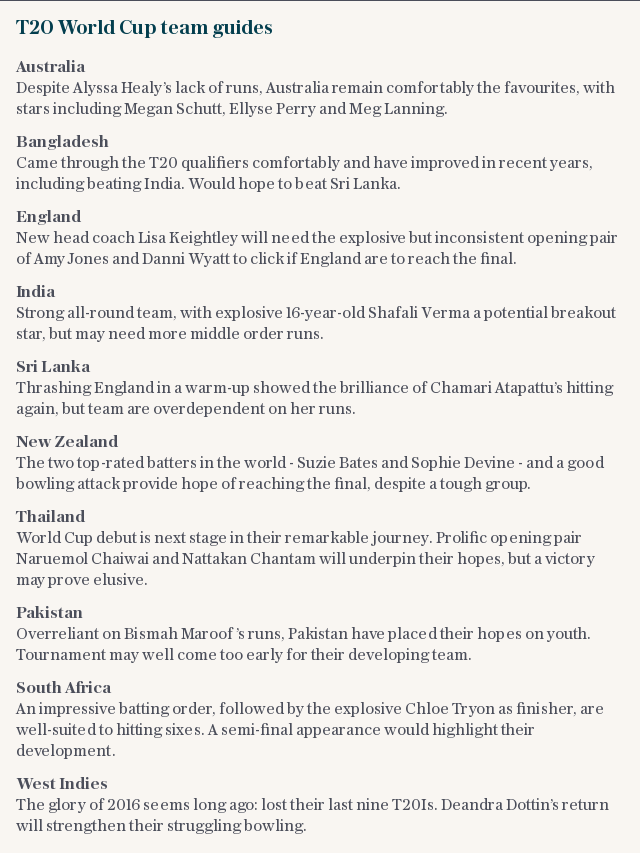Thailand's cricket team: the journey from not understanding the rules to a World Cup debut


It would not be unfair to describe the scenes following the Women's T20 World Cup warm-up match between New Zealand and Thailand as unusual.
New Zealand's players, fresh from a 81-run victory, sat down and gave coaching advice and tactics to their beaten opponents. For those who place importance on competitive advantage, it may seem odd on the eve of the tournament, even if they are miles apart in playing quality. But the images of sportsmanship - of the players mingling together, of New Zealand captain Sophie Devine explaining how to rotate the strike and opener Suzie Bates talking footwork - were met with widespread praise.
It was another heart-warming moment in the incredible rise of Thailand women's cricket team, a journey that has seen them go from not even understanding the rules to a World Cup debut against the West Indies on Saturday morning inside 13 years.
How good is this?
After today's game between New Zealand and Thailand, the @WHITE_FERNS spent time chatting with the @ThailandCricket squad offering tips and expertise ahead of Thailand's maiden #T20WorldCup appearance 👏 #SpiritOfCricket pic.twitter.com/7seHTFfp0D— T20 World Cup (@T20WorldCup) February 19, 2020
"To play in World Cup is any cricketer's dream," captain Sornnarin Tippoch tells Telegraph Sport. "Our dream is now a reality and we want to be an inspiration to nations in our region that these dreams are possible if you are true to the craft." As someone who has never missed a game for her country, the skipper is well placed to describe the progress of her sport, one currently played by over 3,000 women in Thailand.
The 33-year-old, from a family of farmers 400km east of Bangkok, was one of the first individuals approached in 2007 after the Cricket Association of Thailand (CAT), having been made an ICC associate member two years previous, decided to target converting sportswomen.
"A lot has changed since I had decided to go on this journey," reflects the former university softball player. "I knew nothing about the sport, there were too many rules and everything was just confusing. On our first tour we lost all our games before lunch, we bowled countless wides, and couldn't hit the ball off the square."
It was in 2007 that the Asian Cricket Council first organised a multi-team women's tournament. Thailand finished last in their group behind Nepal, Hong Kong and Malaysia, scoring 40 all out in their three games.
But the CAT decision-makers resolved to keep supporting the project, as they were the men. Whereas previously cricket was traditionally played among ex-pats, they wanted to grow the culture in Thailand.

"We realised that we had all the attributes of becoming a very good team fuelled by passion, determination, and natural athletic abilities required for the sport," says Shan Kader, CAT development manager.
"We also knew to be sustainable we had to start growing our own crop from the grassroots to supply the pipeline that feeds the national squads. Mostly now the team are products made by our own set up which puts us in a good position for the future."
Whereas only three other provinces other than Bangkok had cricket played by local Thais in 2007, the country now counts 14 provinces with age groups for boys, girls, men and women.
As for the women, they continued to progress. The debut of women's cricket at the 2010 Asian Games brought exposure and the national team won their first senior title at the 2013 ACC Women's Championship.
But despite beating their first full ICC member in Sri Lanka in 2018, they were still unable to make necessary in-roads at T20 and 50-over World Cup qualifiers, losing every group match in 2015, 2017 and 2018.

The appointment in 2018 of head coach Harshal Pathak, a man described by Kader as 'pivotal', helped them over that bump. Possessing impressive man-management skills and an eye for detail, Pathak favours match simulations and preparation over excessive net sessions.
Last year they won the T20 World Cup Asia qualifier to progress to the global qualifiers in Scotland, where they topped their group and beat semi-finalists Papua New Guinea to reach the World Cup. In among that was a run of 17 consecutive women's T20 wins to August 2019, breaking Australia's previous record.
"When I took over, I noticed the players were very talented and had the ability to bat, bowl and field well.There was a need to put in a lot of tactical work," recalls Pathak, a former first-class cricketer from India.
"Our team needed to change mindset, and the change was to be more aggressive when we batted bowled or fielded. We worked very hard on the smartness in batting and working on the tactics of bowling."
The team is desperate to finish in the top eight in Australia to avoid going back to the qualifiers but equally it is an opportunity to show cricket in Thailand is a serious prospect for girls.
Preparation has been exhaustive and unity is key. The customary post-match ritual of bowing to the field and spectators as a sign of respect will become a regular sight at the tournament, as will the players' smiles.
"There is a lot more excitement in the Thailand cricket community and the sport seems to be heading in the right direction," remarks Kader. "To see the girls now makes me extremely proud. We belong on the world stage."

